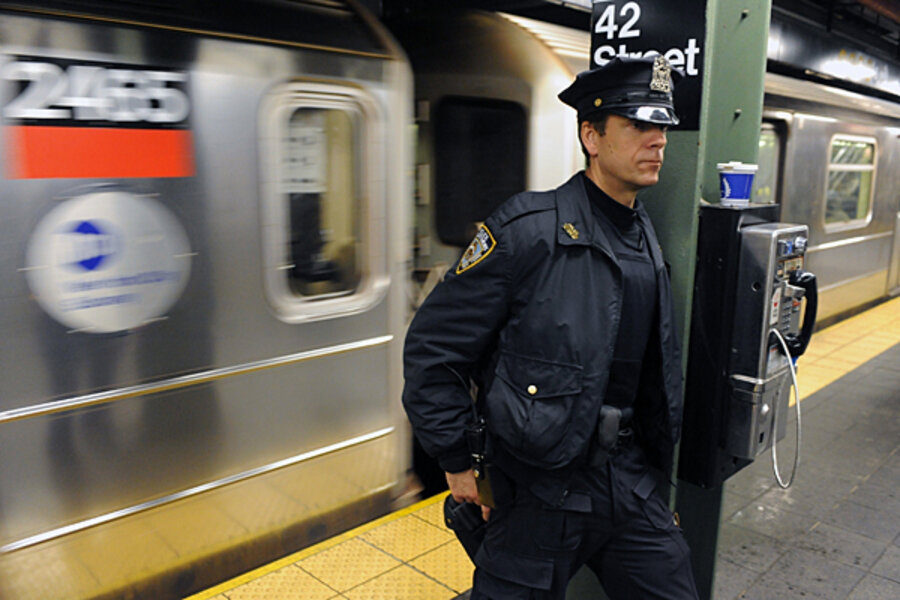Moscow subway attack: Five ways to make mass transit safer
Loading...
Mass-transit systems across the world responded to the Moscow subway attack by heightening security. But such knee-jerk reactions only expose the weakness of subway security, experts say.
Security on mass-transit systems should be a daily priority, like in airports, they add, suggesting that subway stations do not have to be soft terrorist targets.
Of course, commuters' expectations that public transit take them a few miles with minimal inconvenience makes it impossible to implement in subways the strict screening that exists in airports.
But the need is great. More than 10.2 billion trips were taken on public transit in 2009. Yet in the first-ever quadrennial security review released by the Department of Homeland Security (DHS) last month, subways are mentioned only once in the 108-page report. As outlined in that report, the most severe threat facing any transportation system is a weapon of mass destruction such as a nuclear device or a biological weapon.
Common-sense steps and new technologies can make mass-transit safer. Here are five ways:
1. 'Gaming technology'
It may sound like something from a Jason Bourne movie but some mass-transit systems, especially in Europe, are using so-called "gaming technology" to turn intelligence into preventing terrorist attacks.
Gaming technology uses an array of hardware, software, and fast processor speeds. It records a scene in real time using 360-degree photography and immersive video – allowing for recording of every direction at the same time. It also often includes global positioning systems (GPS) and inertial guidance systems (IGS) for tracking and positioning information.
If the computer picks up on a possible situation – say, a passenger has a dirty bomb or a bioweapon – a series of actions will occur. The train’s driver will be notified, the entrance and exits doors may electronically be opened or closed depending on the situation.
2. PROTECT
Just as companies are providing next-generation surveillance technologies for trains, they are also trying to transform security in stations. One example is PROTECT, which consists of hardware and software that can provide automated detection of a terrorist attack.
The exact suite of technologies in PROTECT, which stands for Program for Response Operations and Technology Enhancements for Chemical/Biological Terrorism, is not made public. But security experts say it contains biological and chemical sensor technology, video, wireless communications, and computer software to simulate the spread of potential contaminants.
Washington has the program in a dozen stations and Boston has also implemented a permanent program. Chicago, San Francisco, and other cities are interested.
“We need the kinds of things that help integrate the data from information that is coming in from sensors and cameras,” says Charlie Fisher, vice president for the Mid-Atlantic Region of Witt Associates, a public safety and crisis management consulting firm. “That information has to be processed for security people in order to improve their situational awareness.”
But there’s a money factor for most transit systems. Federal funding does not cover the cost, nor do subway operators' general funds. Mr. Fisher says many municipalities are pushing DHS for more federal grants to support such mass-transit detection systems.
3. Germ Warfare
The Houston Metro system has successfully tested the Breathe Safe System, which uses Ultraviolet Germicidal Irradiation to kill up to 99 percent of certain types of bacteria. The primarily goal is hygienic: preventing the spread of viruses such H1N1, bacteria, or mold.
But the technology is also evolving to prevent against a biological attack on a mass transit system. Many office buildings already use this technology to guard against an airborne threat. The next step would be to add the such systems to subways in major metropolitan areas.
4. Blankets
New York City recently received some new tools in its battle against a possible attack: shields, vests, and blankets made from Demron, a state-of-the-art fabric blend that blocks chemical, biological, and nuclear agents.
The shields and vests would be used by first responders. Blankets would be thrown over radiation victims to keep them from irradiating others. Another blanket – the “Hi-Energy Nuclear Suppression Blanket” – is designed to be placed over a dirty bomb about to go off. It traps chemical, biological, and nuclear agents and reduces by more than half the distance they can spread.
One goal is to make these blankets as common on subways as oxygen masks are on planes.
5. Emergency preparedness
The old tried-and-true security drill is still the best, security experts say.
Transit systems regardless of size and capacity should have a plan for all possible disasters. Conducting exercises regularly is also crucial to avoiding a disaster or preventing mass causalities.
Earlier this week, the Washington Metropolitan Area Transit Authority held two emergency response exercises involving simulated explosions on Metrorail and Metrobus “to test and practice the multi-jurisdictional coordination and response needed to mitigate such incidents,” according to WMATA Metrorail’s website.





